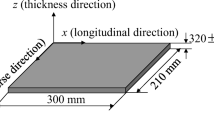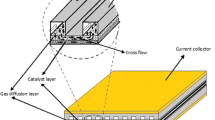Abstract
Experimental and numerical studies of the effects of an anisotropic gas diffusion layer (GDL) on the performance of a dead-end fuel cell system were carried out. The performance of a dead-end mode fuel cell system with aligning the machine direction of an anisotropic GDL in parallel (0º GDL) and perpendicular (90º GDL) direction to the main flow direction of the channel was examined. First, the deformation and intrusion of 0º and 90º GDLs were compared. Then, the permeability of each GDL under the rib part was measured. Using measured values, a model to analyze the current density distribution within the cell was developed. Lastly, the performance of the dead-end mode fuel cell was analyzed using both GDLs. The performance of the fuel cell improved by 3.6 % when the 90o GDL was introduced to the dead-end mode fuel cell compared with that of the 0o GDL. Moreover, the purge interval of the 90o GDL was 1.7 times longer than that of the 0o GDL. Therefore, the cell performance and utilization of fuel improve when the 90o GDL was introduced to the dead-end fuel cell system.
Similar content being viewed by others
Abbreviations
- K :
-
Permeability
- P :
-
Pressure
- U :
-
Superficial velocity
- μ :
-
Viscosity
- R :
-
Universal gas constant
- T :
-
Temperature
- M :
-
Molecular weight
- m̄:
-
Mass flux
- L :
-
Length
- δ GDL :
-
Thickness of GDL
- δ GDL,rib :
-
Thickness of GDL under the rib
- ε :
-
Porosity
- ε c :
-
Porosity of compressed GDL
- η c :
-
Cathode overpotential
- η a :
-
Anode overpotential
- IR :
-
Ohmic loss
- t m :
-
Membrane thickness
- σ m :
-
Membrane conductivity
- F:
-
Faraday number
- I O,C :
-
Cathode exchange current density
- I O,A :
-
Anode exchange current density
References
D. K. Kim, J. H. Seo, S. Kim, M. K. Lee, K. Y. Nam, H. H. Song and M. S. Kim, Efficiency improvement of a PEMFC system by applying a turbocharger, International Journal Hydrogen Energy, 39 (2014) 20139–20150.
D. K. Kim, H. E. Min, I. M. Kong, M. K. Lee, C. H. Lee, M. S. Kim and H. H. Song, Parametric study on interaction of blower and back pressure control valve for a 80-kW class PEM fuel cell vehicle, International Journal Hydrogen Energy, 41 (2016) 17595–17615.
L. Dumercy, M. Pera, R. Glises, D. Hissel, S. Hamandi and F. Badin, PEFC stack operating in anodic dead end mode, Fuel Cell, 4 (2004) 352e7.
C. Yang, S. Moon and Y. Kim, A fuel cell/battery hybrid power system for an unmanned aerial vehicle, Journal of Mechincal and Science and Technolgy, 30 (5) (2016) 2379–2385.
D. McKay, W. Ott and A. Stefanopoulou, A study on the flooding problems and gas purge in the dead-end, Proceedings of IMECE’05 2005 ASME International Mechanical Engineering Congress & Expedition, Orlando, USA (2005) 5–11.
S. Hikita, F. Nakatani, K. Yamane and Y. Takagi, Power-generation in dead-end hydrogen fuel cell, JSAE Rev., 23 (2002) 177e82.
O. Himanen, T. Hottinen and S. Tuurala, Operation of a planar free breathing PEMFC in a dead-end mode, Electrochemical Community, 9 (2007) 891–894.
Ph. Moçotéguy, F. Druart, Y. Bultel, S. Besse and A. Rako-tondrainibe, Monodimensional modeling and experimental study of the dynamic behavior of proton exchange membrane fuel cell stack operating in dead-end mode, Journal of Power Sources, 167 (2007) 349–357.
A. P. Sasmito and A. S. Mufumdar, Performance evaluation of a polymer electrolyte fuel cell with a dead-end anode: A computational fluid dynamic study, International Journal of Hydrogen Energy, 36 (2011) 10917–10933.
J. W. Choi, Y. S. Hwang, S. W. Cha and M. S. Kim, Experimental study on enhancing the fuel efficiency of an anodic dead-end mode polymer electrolyte membrane fuel cell by oscillating the hydrogen, International Journal of Hydrogen Energy, 35 (2010) 12469–12479.
H. Ju, Investigation of the effects of the anisotropy of gas-diffusion layers on heat and water transport in polymer electrolyte fuel cells, Journal of Power Sources, 191 (2009) 259–268.
R. Wu et al., Determination of oxygen effective diffusivity in porous gas diffusion layer using a three-dimensional pore network model, Electrochem Acta, 55 (2010) 7394–7403.
W. W. Yang, T. S. Zhao and Y. L. He, Modelling of coupled electron and mass transport in anisotropic proton-exchange membrane fuel cell electrodes, Journal of Power Sources, 185 (2008) 765–775.
M. F. Serincan and U. Pasaogullari, Effect of gas diffusion layer anisotropy on mechanical stresses in a polymer electrolyte membrane, Journal of Power Sources, 196 (2011) 1314–1320.
G. He, Y. Yamazaki and A. Abudula, A three-dimensional analysis of the effect of anisotropic gas diffusion layer(GDL) thermal conductivity on the heat transfer and two-phase behavior in a proton exchange membrane fuel cell(PEMFC), Journal of Power Sources, 195 (2010) 1551–1560.
J. H. Seo, K. D. Baik, D. K. Kim, S. Kim, J. W. Choi, M. Kim, H. H. Song and M. S. kim, Effects of anisotropic bending stiffness of gas diffusion later on the MEA degradation of polymer electrolyte membrane fuel cells by wet/dry gas, International Journal Hydrogen Energy, 38 (2013) 16245–16252.
J. H. Seo, Studies on the performance and degradation characteristics by GDL anisotropy of PEMFC, Doctoral Dissertation, Seoul Nation University (2013).
J. Geertsma, Estimating the coefficient of inertial resistance in fluid flow through porous media, Journal of Petroleum Science and Engineering, 10 (1974) 445–450.
P. H. Chi, S. H. Chan, F. B. Weng, A. Su, P. C. Sui and N. Djilali, On the effects of non-uniform property distribution due to compression in the gas diffusion layer of a PEMFC, International Journal of Hydrogen Energy, 35 (2010) 2936–2948.
ES-PEMFC Methodology and Tutorial Manual, http://www.myadapco.com.
N. Ahmadi, S. Rezazadeh, I. Mizaee and N. Pourmahmoud, Three-dimensional computational fluid dynamic analysis of the conventional PEM fuel cell and investigation of prominent gas diffusion layers effect, Journal of Mechanical Science and Technology, 26 (8) (2012) 2247–2257.
D. K. Kim, J. S. Lee, J. Kim, M. S. Kim and M.S. Kim, Parametric study and performance evaluation of an organic Rankine cycle (ORC) system using low-grade heat at temperatures below 80 °C, Applied Energy, 189 (2017) 55–65.
J. T. Gostick, M. W. Fowler, M. D. Pritzker, M. A. Ioannidis and L. M. Behra, In-plane and through-plane gas permeability of carbon fiber electrode backing layers, Journal of Power Sources, 162 (2006) 228–238.
T. Lee and C. Yang, A parametric study on the deformation of gas diffusion layer in PEM fuel cell, Journal of Mechanical Science and Technology, 34 (1) (2020) 259–268.
Acknowledgments
This work was supported by Basic Science Research Program through the National Research Foundation of Korea (NRF) funded by the Ministry of Science and ICT [grant numbers NRF-2019R1F1A1058036, NRF-2019M3E6A1064705], Korea Institute of Energy Technology Evaluation and Planning (KETEP) and Korea Evaluation Institute of Industrial Technology (KEIT) grant funded by the Korea government (MOTIE) (No. 20192050100060, Chemisorption heat pump system using heat pump system using electrochemical compressor, and No 20007892, Development of tube skid using pressure vessels (700 bar class 1400 liters) made of towpreg with a single shipment for hydrogen of 1 ton or more and a total weight of 20 ton or less).
Author information
Authors and Affiliations
Corresponding author
Additional information
Recommended by Editor Yong Tae Kang
Jeoung-hoon Seo obtained his B.S. from Republic of Korea Naval Academy, and M.S. and Ph.D. degrees in Mechanical Engineering from Seoul National University, Seoul, South Korea. His research interests include thermodynamics and polymer electrolyte membrane fuel cell.
Dong Kyu Kim obtained his B.S., M.S. and Ph.D. degrees in Mechanical Engineering from Seoul National University, Seoul, South Korea. His research interests include thermodynamics and polymer electrolyte membrane fuel cell, and fuel cell vehicle.
Rights and permissions
About this article
Cite this article
Seo, Jh., Kim, D.K. Effect of anisotropic structure of gas diffusion layer on the cathode dead-end mode of polymer electrolyte membrane fuel cells for the submarine. J Mech Sci Technol 34, 2225–2233 (2020). https://doi.org/10.1007/s12206-020-0444-5
Received:
Revised:
Accepted:
Published:
Issue Date:
DOI: https://doi.org/10.1007/s12206-020-0444-5




